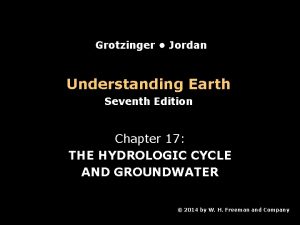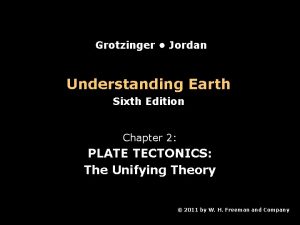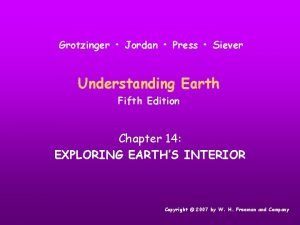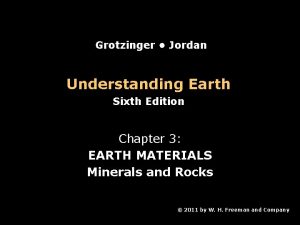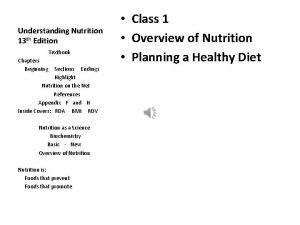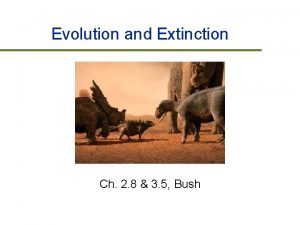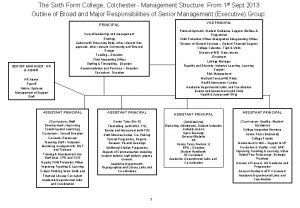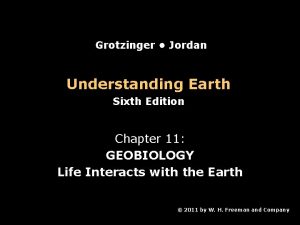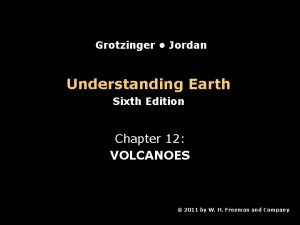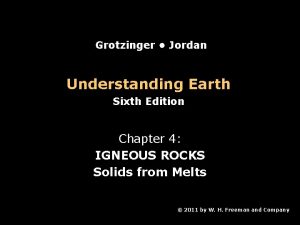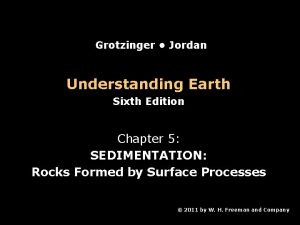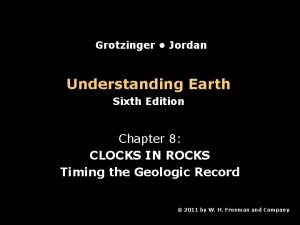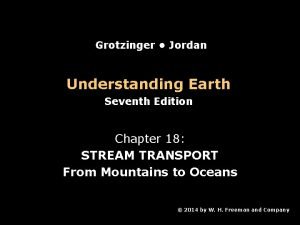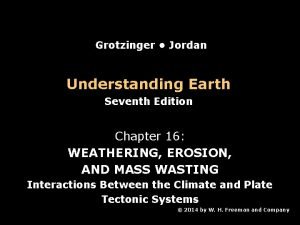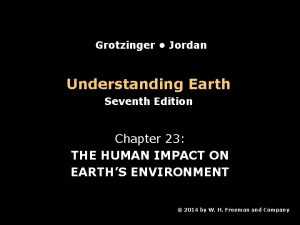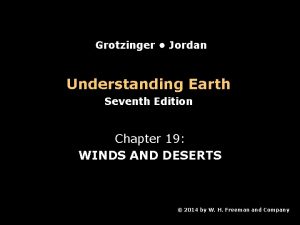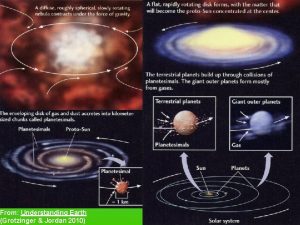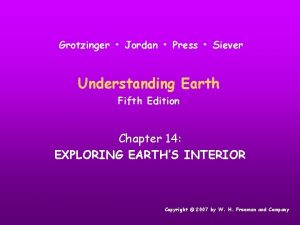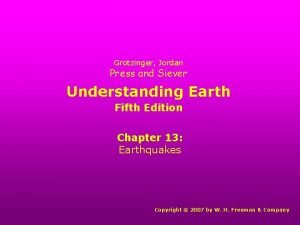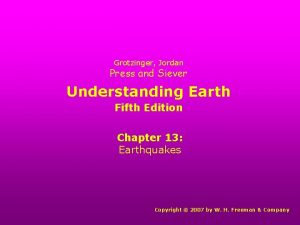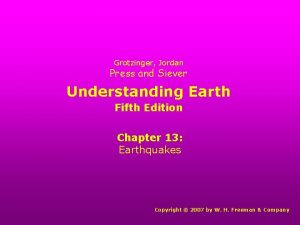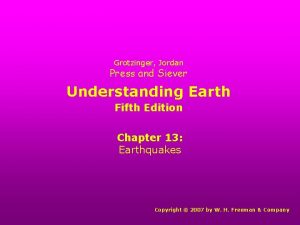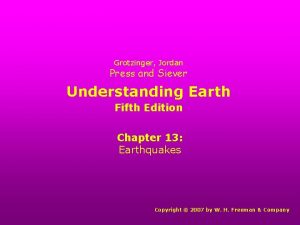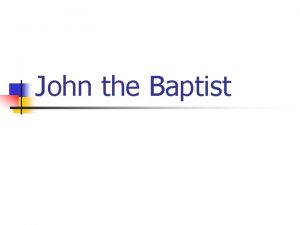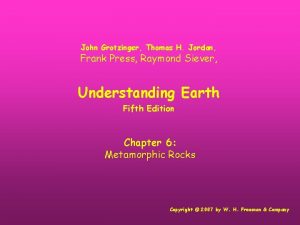Grotzinger Jordan Understanding Earth Sixth Edition Chapter 6




































































- Slides: 68

Grotzinger • Jordan Understanding Earth Sixth Edition Chapter 6: METAMORPHISM Modification of Rocks by Temperature and Pressure © 2011 by W. H. Freeman and Company

Chapter 6: Metamorphism: Alteration of Rocks by Temperature and Pressure

About Metamorphism • Changes in heat, pressure, and the chemical environment of rocks can alter mineral compositions and crystalline textures, making them metamorphic. • Metamorphic changes occur in the solid state, so there is no melting.

Lecture Outline 1. Causes of metamorphism 2. 2. Types of metamorphism 3. 3. Metamorphic textures 4. 4. Regional metamorphism and metamorphic grade 5. 5. Plate tectonics and metamorphism

1. Causes of Metamorphism ● internal heat of Earth ● internal pressure of Earth ● fluid composition inside Earth

1. Causes of Metamorphism ● temperature increases with depth ● rate = 20º to 60ºC per km ● at 15 km depth: 450ºC

1. Causes of Metamorphism ● pressure and temperature increase with depth in all regions


1. Causes of Metamorphism

1. Causes of Metamorphism ● the role of temperature ● geothermal gradient ● shallow (20ºC / km) ● steep (50ºC / km)

1. Causes of Metamorphism ● the role of pressure (stress) ● confining pressure ● directed pressure

1. Causes of Metamorphism ● the role of pressure (stress) ● rate of increase = 0. 3 to 0. 4 kbar / km ● minerals are geobarometers

Thought questions for this chapter At what depths in the Earth do metamorphic rocks form? What happens if temperatures get too high? Why are there no metamorphic rocks formed under natural conditions of very low pressure and temperature, as shown in Figure 6. 1?

2. Types of Metamorphism ● the role of fluids ● metasomatism ● accelerated chemical reactions

2. Types of Metamorphism Depth, km 0 Con tine 35 nta l cr Con ust tine nta lm 75 ant le As th en osp he re Oceanic crust lith osp Oceanic lithosphere her e

Shock metamorphism Depth, km 0 Con tine 35 nta l cr Con ust tine nta lm 75 ant le As th en osp he re Oceanic crust lith osp Oceanic lithosphere her e

Regional metamorphism Shock metamorphism Depth, km 0 Con tine 35 nta l cr Con ust tine nta lm 75 ant le As th en osp he re Oceanic crust lith osp Oceanic lithosphere her e

Regional metamorphism Shock metamorphism Depth, km 0 Con tine 35 nta l cr Con ust tine nta lm 75 ant le As th en osp he re High-pressure metamorphism Oceanic crust lith osp Oceanic lithosphere her e

Regional metamorphism Shock metamorphism Depth, km 0 Con tine 35 nta l cr Con ust tine nta lm 75 ant le As th en osp he re High-pressure metamorphism Contact metamorphism Oceanic crust lith osp Oceanic lithosphere her e

Regional metamorphism Shock metamorphism Depth, km 0 Con tine 35 nta l cr Con ust tine nta lm 75 ant le As th en osp High-pressure metamorphism Contact metamorphism Oceanic crust lith osp Oceanic lithosphere her e he re Burial metamorphism

Regional metamorphism Shock metamorphism Depth, km 0 Con tine 35 nta l cr Con ust tine nta lm 75 ant le As th en osp High-pressure metamorphism Contact metamorphism Oceanic crust lith osp Oceanic lithosphere her e he re Water Burial metamorphism Seafloor metamorphism

Thought questions for this chapter Draw a sketch showing how seafloor metamorphism might take place.

3. Metamorphic Textures


3. Metamorphic Textures Staurolite crystal Mica

Foliated rocks contain platy minerals that are aligned along a preferred orientation. Staurolite crystal Mica

3. Metamorphic Textures Feldspar Quartz Mica Pyrite Staurolite

Foliation is the result of compressive forces. Feldspar Quartz Mica Pyrite Staurolite

Foliation is the result of compressive forces. Mineral crystals become elongated perpendicular to the compressive force. Feldspar Quartz Mica Pyrite Staurolite

3. Metamorphic Textures ● preferred orientation of crystals ● slaty cleavage ● foliation

3. Metamorphic Textures shale sandstone layers 5 cm

The original bedding can be seen in the thin sandy layers. shale sandstone layers 5 cm

The original bedding can be seen in the thin sandy layers. foliation plane shale sandstone layers original bedding 5 cm

The original bedding can be seen in the thin sandy layers. Regional metamorphism causes cleavage planes to develop. foliation plane shale sandstone layers original bedding 5 cm

3. Metamorphic Textures Low grade Intermediate grade

3. Metamorphic Textures Diagenesis Slate Slaty cleavage Low grade Intermediate grade Phyllite High grade Schist (abundant micaceous minerals) Gneiss (fewer micaceous minerals) Migmatite Schistosity Banding

Foliated rocks are classified by the degree of cleavage, schistosity, and banding. Diagenesis Slate Slaty cleavage Low grade Intermediate grade Phyllite High grade Schist (abundant micaceous minerals) Gneiss (fewer micaceous minerals) Migmatite Schistosity Banding

3. Metamorphic Textures ● classification of foliated rocks ● metamorphic grade ● crystal size ● type of foliation ● banding

3. Metamorphic Textures ● nomenclature of foliated rocks ● slate ● phyllite ● schist ● gneiss ● migmatite

Foliated texture: schist with garnet porphroblasts

3. Metamorphic Textures ● nomenclature of granoblastic (non-foliated) metamorphic rocks ● hornfels ● quartzites ● marbles ● greenstones ● amphibolites ● granulites (granofels)

Granoblastic Texture


Thought questions for this chapter How is slaty cleavage related to tectonic forces? What forces cause minerals to align with one another? Would you choose to rely on chemical composition or type of foliation to determine metamorphic grade? Why?

4. Regional Metamorphism and Metamorphic Grade ● grades of metamorphism ● low ● intermediate ● high

4. Regional Metamorphism and Metamorphic Grade ● mineral isograds (zones of change) ● index minerals reflect pressure and temperature conditions ● groups of 2 to 3 index minerals form an isograd

4. Regional Metamorphism Canada ME NY Isograds VT NH Key: MA CT RI Low grade Medium grade High grade Not metamorphosed Chlorite zone Biotite zone Garnet zone Staurolite zone Sillimanite zone

Index minerals define metamorphic zones. Canada ME NY Isograds VT NH Key: MA CT RI Low grade Medium grade High grade Not metamorphosed Chlorite zone Biotite zone Garnet zone Staurolite zone Sillimanite zone

Index minerals define metamorphic zones. Isograds can be used to plot the level or degree of metamorphism. Canada ME NY Isograds VT NH Key: MA CT RI Low grade Medium grade High grade Not metamorphosed Chlorite zone Biotite zone Garnet zone Staurolite zone Sillimanite zone

Inc rea s Pressure (kilobars) Slate ing met amo Intermediate Grade Phyllite rph ic gra de High Grade Schist Blueschist Gneiss Migmatite Temperature (°C) Depth (km) Low Grade




n uctio zone 20 0 200 400 10 Granulite Subd 13. 5 Greenschist st hi sc ue 10 5 Amphibolite 5 Bl Pressure (kilobars) ite Contac t meta morph Con ism mo dition unt ain s ben bel eath ts Partial meltin g begins Ze ol 15 0 Hornfels 15 20 25 Depth (km) 0 30 Eclogite 35 600 40 1000 800 Temperature (°C) Metamorphic facies correspond to particular combinations of pressure and temperature. . . … and can be used to indicate specific tectonic environments.

Thought questions for this chapter You have mapped an area of metamorphic rocks, such as the region in Figure 6. 9 a, and have observed a series of metamorphic zones, marked by north-south isograds, running from sillimanite in the east to chlorite in the west. Were metamorphic temperatures higher in the east or west? Which kind of pluton would produce the highest grade of metamorphism, a granite intrusion 20 km deep or a gabbro intrusion at a depth of 5 km?

5. Plate Tectonics and Metamorphism ● metamorphism occurs in or near ● plate interiors ● divergent plate margins ● convergent plate margins ● transform plate margins

Tectonic transport moves rocks through different pressure-temperature zones, … Low P, Low T High P, High T

Tectonic transport moves rocks through different pressure-temperature zones, … Low P, Low T High P, High T …and then transports them back to the shallow crust or the surface.

5. Plate Tectonics and Metamorphism ● metamorphic pressure-temperature paths ● history of burial and exhumation ● prograde and retrograde paths

5. Plate Tectonics and Metamorphism

The garnet crystal initially grows in a schist but ends up growing in a gneiss. RE TR O GR PR O te lli y Ph Pressure (kilobars) te Low Grade AD G EP AT H Intermediate Grade Depth (km) Sla R A D E PA TH Sch ist Temperature (°C) Gneiss High Grade

H TH PA TH DE PA DE PR OG RA DE High Grade PA T H Peak metamorphism Temperature (°C) Low temperature– high pressure metamorphism within a subduction zone Continental crust Deep-ocean Shelf sediment Oceanic crust Trench Mélange ophiolites Continental crust Prograde path Peak metamorphism Retrograde path Depth (km) PA T RA RA OG PR Pressure (kilobars) DE OG TR RE Low RE TR Grade OG RA

H TH PA TH DE PA DE PR OG RA DE High Grade PA T Depth (km) PA T RA RA OG PR Pressure (kilobars) DE OG TR RE Low RE TR Grade OG RA H Peak metamorphism Temperature (°C) Low temperature– high pressure metamorphism within a subduction zone Continental crust Deep-ocean Shelf sediment Oceanic crust Trench Mélange ophiolites High temperature– high pressure metamorphism within a mountain belt Suture Continental crust Multiple thrusts Deformed and metamorphosed shallow- and deepocean sediments Continental crust Prograde path Peak metamorphism Prograde path Retrograde path Peak metamorphism Retrograde path

5. Plate Tectonics and Metamorphism ● rapid erosion (exhumation) rates of mountain ranges show a relationship between ● tectonics (orogeny) ● climate ● controls the flow of metamorphic rocks to the surface

Thought questions for this chapter Draw a sketch showing how seafloor metamorphism might take place. Subduction zones are generally characterized by highpressure low temperature metamorphism. In contrast, continent-continent collision zones are marked by moderate pressure high temperature metamorphism. Which type of plate boundary has a higher geothermal gradient? Explain.

Key terms and concepts Amphibolite Blueschist Burial metamorphism Contact metamorphism Eclogite Exhumation Foliated rock Foliation Gneiss Granoblastic rock Granulite Greenschist Greenstone High-pressure metamorphism Hornfels

Key terms and concepts Marble Mélange Metamorphic facies Metasomatism Migmatite Phyllite Porphroblast Quartzite Regional metamorphism Schist Seafloor metamorphism Shock metamorphism Slate Stress Suture

Key terms and concepts Ultra-high pressure metamorphism Zeolite
 The sixth sheik's sixth sheep's sick
The sixth sheik's sixth sheep's sick The sixth sick sheik's sixth sheep's sick lyrics
The sixth sick sheik's sixth sheep's sick lyrics Understanding earth 7th edition
Understanding earth 7th edition Understanding earth 6th edition
Understanding earth 6th edition Understanding earth 5th edition
Understanding earth 5th edition Earth 6th edition
Earth 6th edition Biochemistry sixth edition 2007 w.h. freeman and company
Biochemistry sixth edition 2007 w.h. freeman and company Computer architecture a quantitative approach sixth edition
Computer architecture a quantitative approach sixth edition Automotive technology sixth edition
Automotive technology sixth edition Automotive technology sixth edition
Automotive technology sixth edition Citation sample pdf
Citation sample pdf Computer architecture a quantitative approach 6th
Computer architecture a quantitative approach 6th Precalculus sixth edition
Precalculus sixth edition Rational people think at the margin
Rational people think at the margin Computer architecture a quantitative approach sixth edition
Computer architecture a quantitative approach sixth edition Adler and rodman 2006
Adler and rodman 2006 Understanding business 12th edition chapter 1
Understanding business 12th edition chapter 1 Understanding nutrition 13th edition rental
Understanding nutrition 13th edition rental Copyright
Copyright Understanding human differences 5th edition
Understanding human differences 5th edition Understanding human communication 14th edition
Understanding human communication 14th edition Understanding intercultural communication 2nd edition
Understanding intercultural communication 2nd edition Using mis 10th edition
Using mis 10th edition Using mis 10th edition
Using mis 10th edition The sixth extinction chapter 3 summary
The sixth extinction chapter 3 summary I hate careless people. that's why i like you
I hate careless people. that's why i like you The great gastby chapter 4 summary
The great gastby chapter 4 summary What are the rumors about gatsby in chapter 3 quotes
What are the rumors about gatsby in chapter 3 quotes How does nick describe the guests at gatsby's party
How does nick describe the guests at gatsby's party Nuast sixth form open day
Nuast sixth form open day Windsor sixth form
Windsor sixth form Shenfield sixth form
Shenfield sixth form Transition words for essays 6th grade
Transition words for essays 6th grade The sixth and ninth commandments
The sixth and ninth commandments Fourth circle of hell punishment
Fourth circle of hell punishment Latymer sixth form
Latymer sixth form Crossley heath sixth form
Crossley heath sixth form Sixth state of matter
Sixth state of matter 6th sunday of easter year c
6th sunday of easter year c Sixth sense ted
Sixth sense ted Little heath sixth form
Little heath sixth form Hamlet's sixth soliloquy
Hamlet's sixth soliloquy Holly smith
Holly smith Blackfen sixth form
Blackfen sixth form Sixth sense technology seminar report
Sixth sense technology seminar report Wholly nutrition btec
Wholly nutrition btec 6th freedom of air
6th freedom of air Solihull sixth form tyber
Solihull sixth form tyber Bfs sixth form
Bfs sixth form Walton high sixth form application
Walton high sixth form application Walton high sixth form
Walton high sixth form Fellowship with god in the sixth path
Fellowship with god in the sixth path Sixth avenue medical pharmacy
Sixth avenue medical pharmacy Shenfield sixth form
Shenfield sixth form In the sixth month angel gabriel
In the sixth month angel gabriel The sixth and ninth commandments
The sixth and ninth commandments Winchmore sixth form open evening
Winchmore sixth form open evening Wickersley sixth form
Wickersley sixth form Chesterton community college open evening
Chesterton community college open evening Walton high sixth form entry requirements
Walton high sixth form entry requirements Iot design methodology has _________steps.
Iot design methodology has _________steps. The sixth sense cinematography
The sixth sense cinematography The sixth form college colchester
The sixth form college colchester The fifth, sixth, seventh, and eighth amendments protect *
The fifth, sixth, seventh, and eighth amendments protect * Sixth sense technology seminar
Sixth sense technology seminar Mill hill county sixth form
Mill hill county sixth form 7th commandment worksheet
7th commandment worksheet Kesgrave 6th form
Kesgrave 6th form Park hall sixth form
Park hall sixth form


